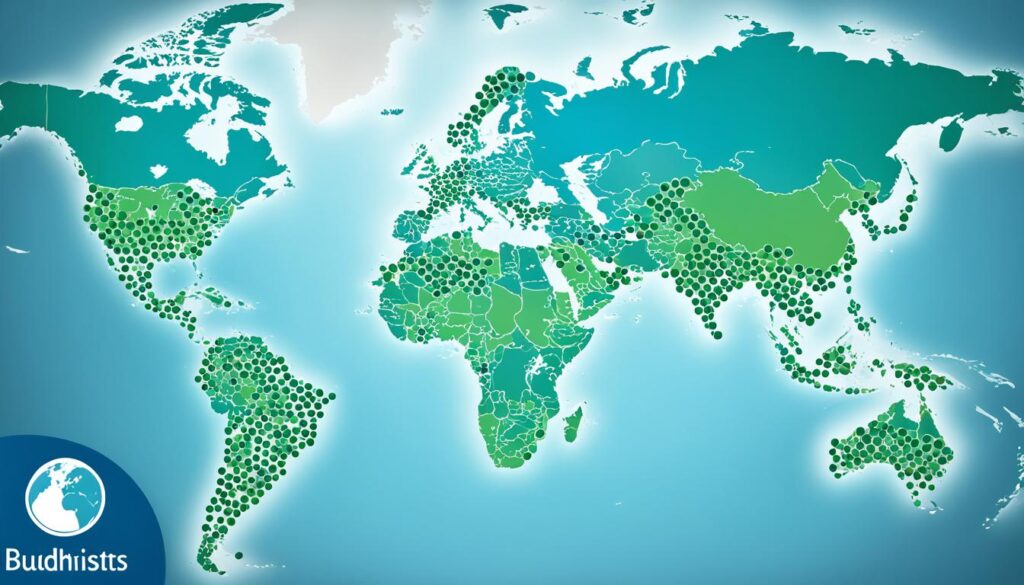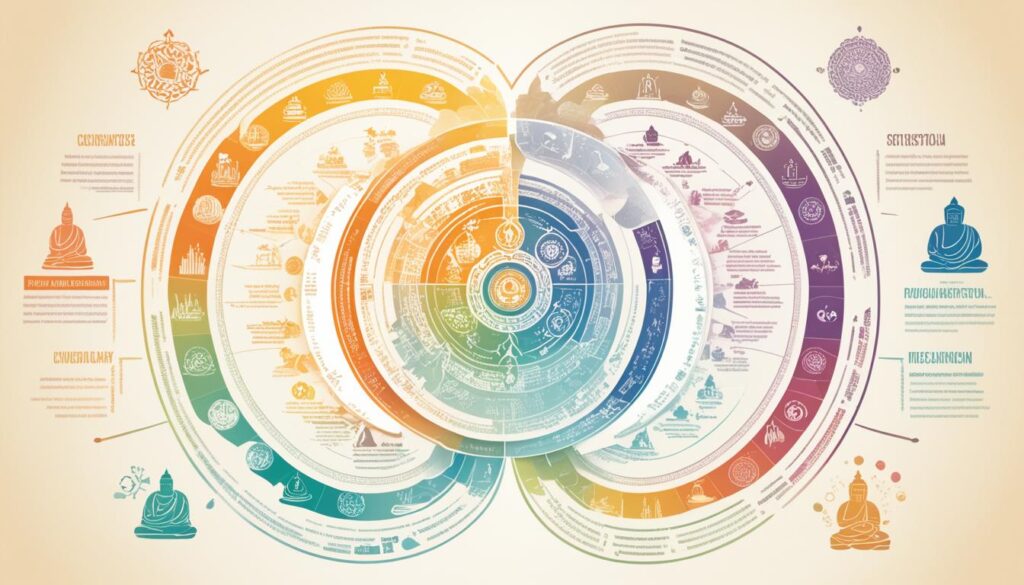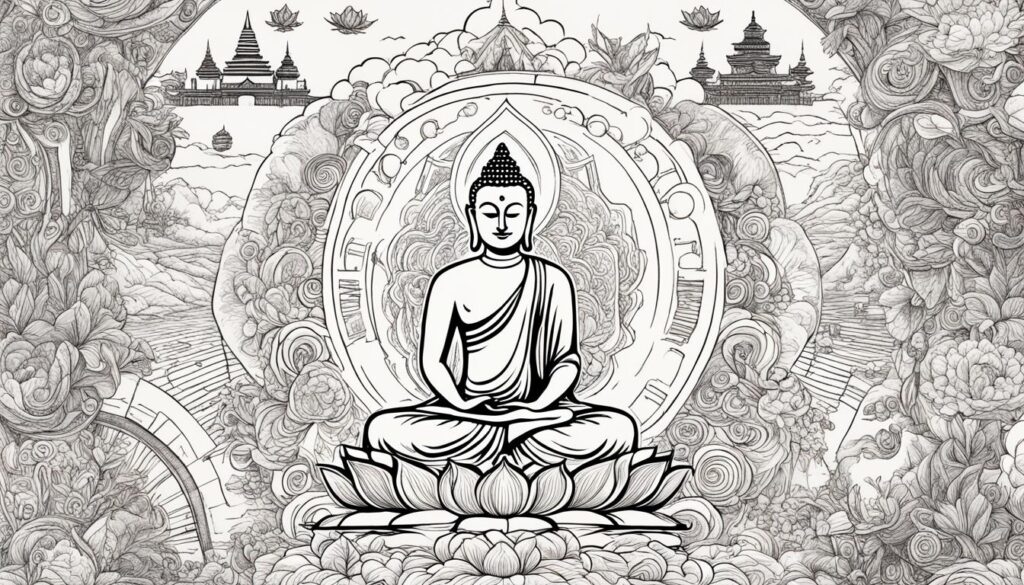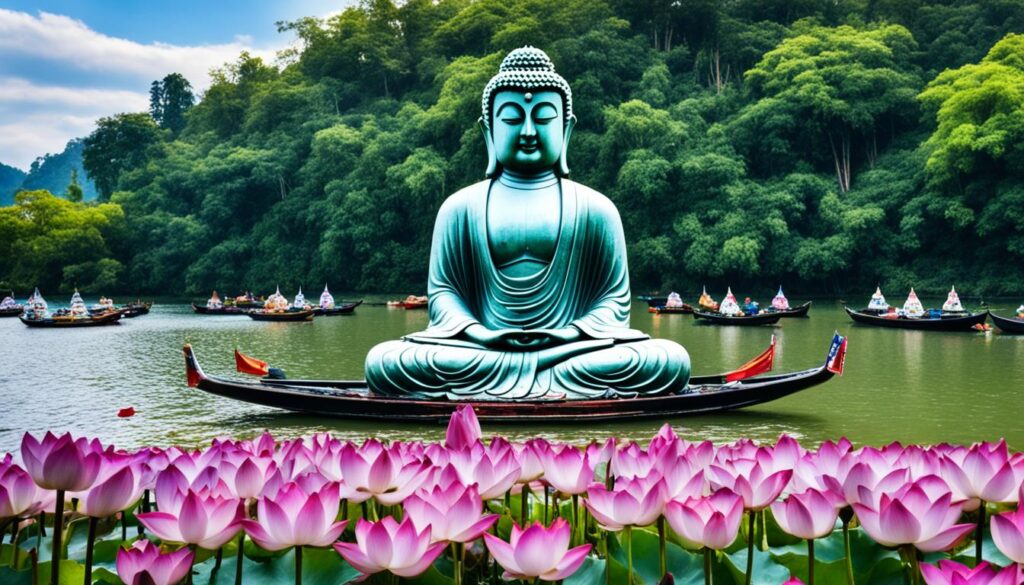“Thousands of candles can be lit from a single candle, and the life of the candle will not be shortened. Happiness never decreases by being shared.” – Buddha
Welcome to a world where the search for inner peace unites millions of souls, transcending borders and cultures. Buddhism, an ancient philosophy and way of life, boasts a remarkable global following. So, just how widespread is Buddhism? Let’s delve into the numbers and explore the demographics, growth trends, and spiritual practices of this profound belief system.
Key Takeaways:
- Buddhism has approximately 488 million followers worldwide.
- The three major branches of Buddhism are Mahayana, Theravada, and Vajrayana.
- The majority of Buddhists (99%) reside in the Asia-Pacific region.
- North America and Europe are home to over 1 million Buddhists each.
- Buddhism emphasizes principles such as compassion, mindfulness, and the pursuit of truth.
The Global Distribution of Buddhists
Buddhism has a global reach, with followers spread across different regions. The Asia-Pacific region has the largest population of Buddhists, with approximately 488 million followers. However, Buddhists account for only 12% of the total population in this region. In North America and Europe, there are over 1 million Buddhists in each region, but they make up less than 1% of the population.
The following table illustrates the distribution of Buddhists worldwide:
| Region | Buddhist Population | Percentage of Regional Population |
|---|---|---|
| Asia-Pacific | 488 million | 12% |
| North America | 1 million | <1% |
| Europe | 1 million | <1% |
The top 10 countries with the highest Buddhist populations are all located in the Asia-Pacific region. China alone is home to half of the world’s Buddhist population. Other countries with significant Buddhist populations include Thailand, Japan, Burma, Sri Lanka, Vietnam, Cambodia, South Korea, India, and Malaysia.

Buddhism’s Growth and Demographics
Buddhists are, on average, older than the general population, with a global median age of 34 compared to 28. The youngest Buddhist population can be found in sub-Saharan Africa, with a median age of 29, while the oldest population is in the Asia-Pacific region, with a median age of 34. In North America, the median age of Buddhists is 33, four years younger than the general population. Buddhism has a significant presence in countries like China, Japan, Thailand, Myanmar, Cambodia, and Sri Lanka, where it is the majority religion.

As Buddhism continues to evolve and expand, its growth and demographics shape its global influence. Understanding the age distribution of Buddhists provides insights into their cultural and societal impact. The concentration of Buddhism in specific regions reflects its historical roots and the influence of local cultures and traditions.
Table: Regional Median Age Comparison
| Region | Median Age (Buddhists) | Median Age (General Population) |
|---|---|---|
| Sub-Saharan Africa | 29 | 28 |
| Asia-Pacific | 34 | 28 |
| North America | 33 | 37 |
| Europe | 39 | 42 |
Note: The median age data represents a broad overview and may vary within specific countries or regions.
Buddhism’s Beliefs and Practices
Buddhism encompasses a unique set of beliefs and practices that guide the lives of its followers. Unlike many other religions, Buddhists do not acknowledge a supreme deity. Instead, the focus is on achieving enlightenment or a state of inner peace and wisdom. This pursuit of enlightenment is characterized by the Three Jewels: Buddha, Dharma, and Sangha.
Central to Buddhist teachings are concepts such as karma and reincarnation. Karma refers to the law of cause and effect, where every action has consequences in this life or the next. Reincarnation, on the other hand, is the belief in the cycle of rebirth, where individuals are born again after death based on their karma.
Buddhism emphasizes morality, meditation, and wisdom on the path to enlightenment. Buddhists strive to follow the Five Precepts, which include refraining from killing, stealing, sexual misconduct, false speech, and intoxication. By adhering to these moral guidelines, practitioners cultivate goodwill, compassion, and ethical conduct.
Meditation plays a significant role in Buddhism, as it helps individuals cultivate mindfulness and develop a deeper understanding of themselves and the world around them. Buddhist monks and nuns devote extensive periods to meditation and mindfulness practices, seeking to eliminate the distractions and attachments of daily life.
Buddhist temples serve as places of worship, community gathering, and learning. Here, believers engage in rituals, chant sutras, make offerings, and participate in ceremonies to deepen their connection to Buddhist teachings. However, worship can also take place at home, where individuals create personal altars and engage in private meditation and prayer.
Buddhist monks follow a strict code of conduct known as the Vinaya. This code governs their behavior and sets guidelines for their monastic life. Monks and nuns renounce worldly possessions, wear simple robes, and dedicate themselves to the pursuit of spiritual enlightenment and the teachings of the Buddha.
Overall, Buddhism is a tolerant and evolving religion, encompassing various philosophical interpretations. It emphasizes principles such as compassion, mindfulness, and the pursuit of truth, inspiring individuals to find inner peace and alleviate suffering in themselves and the world.

| Key Beliefs and Practices | Description |
|---|---|
| Karma | The law of cause and effect, where actions have consequences. |
| Reincarnation | The belief in the cycle of rebirth based on karma. |
| Morality | Adhering to ethical guidelines such as the Five Precepts. |
| Meditation | Cultivating mindfulness and deeper understanding through meditation practices. |
| Worship | Engaging in rituals and ceremonies at temples or home altars. |
| Monastic Life | Buddhist monks and nuns’ strict code of conduct and dedication to spiritual pursuit. |
Buddhism’s History and Traditions
Buddhism, founded by Siddhartha Gautama, also known as the Buddha, has a rich history that dates back over 2,500 years in India. Siddhartha Gautama renounced his privileged life and embarked on a quest to seek enlightenment. After years of intense meditation under a Bodhi tree, he achieved enlightenment and became the Buddha, meaning the “Awakened One”.
The Buddha dedicated the remainder of his life to spreading his teachings and guiding others towards enlightenment. His teachings emphasized the importance of understanding the causes of suffering and the pursuit of inner peace and wisdom.
Over time, Buddhism expanded beyond India, thanks to the efforts of great leaders like Ashoka the Great. In the 3rd century B.C., Ashoka made Buddhism the state religion of his empire, marking a significant milestone in its spread. Today, Buddhism is practiced in various forms around the world, including Theravada Buddhism, Mahayana Buddhism, and Vajrayana Buddhism (Tibetan Buddhism).
Theravada Buddhism, often found in Southeast Asia, focuses on the original teachings of the Buddha and emphasizes individual enlightenment through meditation and self-discipline. Mahayana Buddhism, prevalent in East Asia, encompasses a broader range of teachings and beliefs, emphasizing compassion and the attainment of enlightenment for the benefit of all beings. Vajrayana Buddhism, practiced mainly in Tibet and its surrounding regions, incorporates esoteric rituals and practices to achieve enlightenment swiftly.
Through its history and diverse traditions, Buddhism has become a global philosophy that transcends religious boundaries, attracting millions of followers worldwide. Its teachings continue to inspire individuals to seek inner peace, cultivate compassion, and navigate the complexities of life.

Key Points:
- Buddhism was founded by Siddhartha Gautama, the Buddha, in India over 2,500 years ago.
- The Buddha renounced his privileged life to seek enlightenment and achieved it while meditating under a Bodhi tree.
- Buddhism spread beyond India when Ashoka the Great made it the state religion of his empire in the 3rd century B.C.
- Today, Buddhism is practiced in different forms worldwide, including Theravada, Mahayana, and Vajrayana Buddhism.
- Theravada Buddhism emphasizes meditation and self-discipline, Mahayana Buddhism focuses on compassion and benefiting all beings, while Vajrayana Buddhism incorporates esoteric practices.
Explore the next section to unravel the profound influence of Buddhism and its role in promoting peace and harmony across cultures and continents.
Unveiling the Profound Influence of Buddhism
Buddhism, with its global following of approximately 488 million practitioners, holds a profound influence worldwide. While prevalent in the Asia-Pacific region, this ancient religion has also gained significant traction in North America and Europe. Buddhism’s core teachings, rooted in mindfulness, compassion, and the pursuit of enlightenment, offer profound insights for personal and societal harmony.
As Buddhism continues to grow and thrive, its demographics and beliefs contribute to its enduring impact across cultures and continents. The religion’s emphasis on ethical conduct, meditation, and the study of Buddhist scriptures empowers its followers to find inner peace and alleviate suffering, both within themselves and in the world around them.
Whether it is through the practice of meditation, the cultivation of compassion, or the exploration of Buddhist teachings, individuals on the Buddhist path continually aspire to transform their lives and better society as a whole. Buddhism’s global reach, encompassing diverse populations and its timeless wisdom, makes it a transformative force that resonates with millions worldwide.
FAQ
How many Buddhists are there worldwide?
According to research, there are approximately 488 million Buddhists worldwide.
What are the major branches of Buddhism?
The three major branches of Buddhism are Mahayana, Theravada, and Vajrayana.
Where are the major Buddhist populations located?
The majority of Buddhists (99%) live in the Asia-Pacific region, followed by North America (3.9 million) and Europe (1.3 million).
Which countries have the largest Buddhist populations?
The 10 countries with the largest Buddhist populations are China, Thailand, Japan, Burma, Sri Lanka, Vietnam, Cambodia, South Korea, India, and Malaysia.
What is the median age of Buddhists globally?
Buddhists are, on average, older than the general population, with a global median age of 34.
What are the core teachings of Buddhism?
Buddhism emphasizes principles such as compassion, mindfulness, and the pursuit of truth.
Who founded Buddhism?
Buddhism was founded by Siddhartha Gautama, also known as the Buddha, over 2,500 years ago in India.
Where is Buddhism predominantly practiced?
Buddhism has a significant presence in countries like China, Japan, Thailand, Myanmar, Cambodia, and Sri Lanka, where it is the majority religion.

